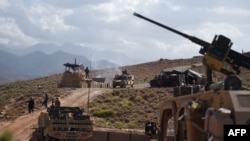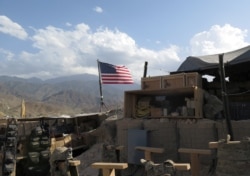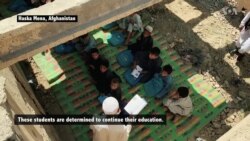Afghan armed forces, supported by U.S. forces, for years have attempted to clear the Islamic State (IS) militants from Haska Mena in the far eastern corner of Afghanistan near the border with Pakistan.
The district, also known as Deh Bala, today is blanketed in despair as the war against IS has reduced it to a wasteland without any significant improvement in security.
During a visit by a Voice of America reporter to the district in the eastern province of Nangarhar this week, locals pointed out that there are hundreds of IS local and foreign fighters in the high peaks of the rugged and steep mountains from where they periodically stage attacks against local security forces and civilians believed to be cooperating with the government.
VOA footage of the area shows a vacant ghost district ransacked by widescale destruction that has left its infrastructure in tatters.
The few residents who have returned to the area told VOA they have little hope that life will return to normal anytime soon.
WATCH: Haska Mena lies in rubble
The district chief of Haska Mena, Rizwanullah Basharmal, is among the few local officials who have returned, despite a government warning that the area remains unsafe. He told VOA that IS militants are extorting money from locals along with illicit smuggling along the villages of the border district to raise money. Additionally, the area provides the militants crisscross routes into the tribal areas of Pakistan.
"They have their hideouts all across these villages," said Basharmal, pointing to Haska Mena's small communities dispersed through the forbidding terrain. "They have foreign fighters such as Punjabis in addition to Afghan citizens."
IS fighters
Basharmal said IS fighters rule several villages of the district after Afghan security forces concluded their operations.
He said the fighters roam, especially between the district and nearby Achin district, where the U.S. on April 2017 dropped its largest non-nuclear bomb, which targeted an IS cave complex.
Haska Mena is home to more than 50,000 people, mostly belonging to the Pashtun tribe of Shinwari. The cave complex and mountain ridges of the region have provided shelter to militants for decades, including the Mujaheddin during the Soviet occupation of Afghanistan.
When the Islamic State in early 2015 established its branch in Afghanistan and Pakistan, known as Islamic State-Khorasan Province, many fighters who had previously worked with Pakistani Taliban in the region pledged allegiance to IS leader Abu Bakir al-Baghdadi.
The region later became a hotbed for IS foreign fighters, including from Kazakhstan, Tajikistan, Syria and Iraq, according to U.S. officials who spoke to The New York Times.
Seeing the remote area as a potential stronghold for IS and a major site to plot high-profile attacks on Kabul and Jalalabad, Afghan and U.S. forces have since conducted several operations to clear the militants.
One major Afghan operation, supported by U.S. Special Forces, was conducted between April and July 2018 and killed 167 IS fighters, according to Afghan officials.
At the time, Joshua Thiel, a U.S. Special Forces battalion commander, told VOA that they had "cleared" Haska Mena of IS.
"The operation started at the end of May. They [Special Forces] put direct fire on the ISIS capital caliphate and put it under siege for about four days. And it took the three commando companies five days to clear Papin and Gur Guri [of IS militants]," Thiel said.
But almost a year later, local accounts from the district say the group displays no signs of a lasting defeat.
Despite the high elevation that hampers Afghan forces' operations, IS has planted landmines in every possible location from houses and shops to farms, according to Mohammed Ghorzang, Haska Mena's educational director.
Ghorzang said IS subjugated tribal residents by beheading and other brutal means in a way that is considered extreme even by the standards of other militant groups, such as the Taliban.
"This is where they beheaded people," Ghorzang said, pointing to an area at the middle of Haska Mena. It is now filled with shattered concrete, but a few years ago it was an open area serving as IS's "execution square."
Mosque now rubble
Pointing at another building which is merely rubble and columns, Ghorzang said, "This used to be the mosque where the governor of Khorasan Province stayed and issued verdicts."
In terms of reparation, Ghorzang charged that little has been done by the government to recover essential buildings, such as schools and hospitals. Children, who are the most vulnerable in the conflict, have to either dropped out of school or study in the open fields.
WATCH: Schools in Haska Mena destroyed
"Haska Mena district used to have 26 school buildings, but only four of them are functional now," Ghorzang added.
Losing hope that their infrastructure will be restored anytime soon, some locals have volunteered to school students in local fields. One of the volunteers, 70-year-old Shamass Khan, said it was the responsibility of adults in the district to make sure children at least learned how to read and write.
"We used to send people from here to universities. Now look at our situation," said Khan, wiping away tears. "Everything is gone. When we see this we can't help but get emotional."
According to Haska Mena district chief Basharmal, the government in Kabul initially assured residents to fully retrieve the region after its operation in July 2018. Yet, it remains unclear when these promises will be fulfilled.
"We have been given many promises from the government to rebuild bridges, roads, schools and clinics. But so far not even a stone has been moved," Basharmal noted.














